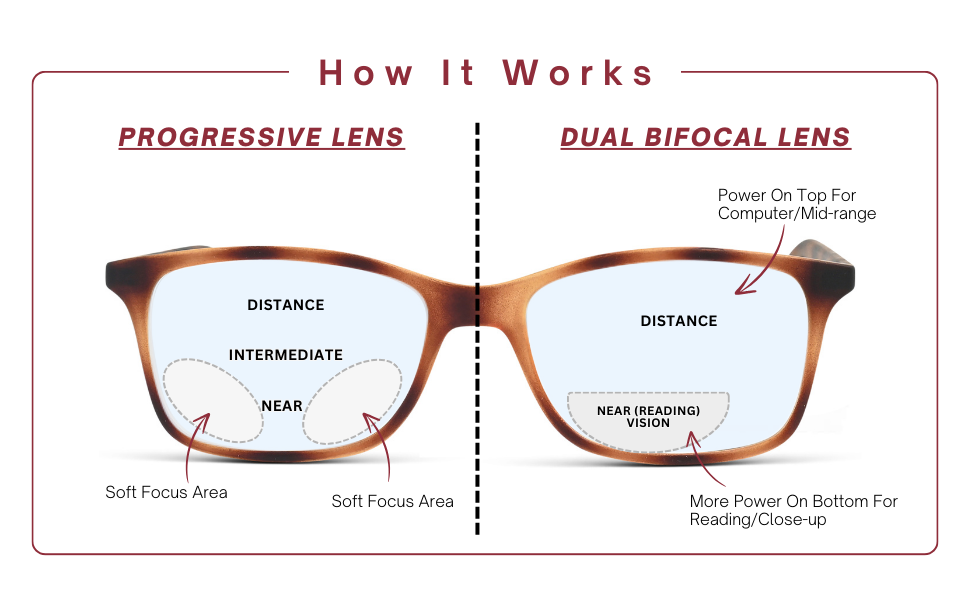
Progressive vs Bifocal: Understanding the Differences
Posted by Team Debby on 7th Mar 2024
Seeing clearly shouldn’t mean sacrificing style—or breaking the bank. If you’re over 40 and noticing that reading menus, scrolling your phone, or even driving at night feels a little blurrier, you’re not alone. Enter progressive lenses and bifocal lenses—two of the most common solutions for presbyopia (the age-related change in near vision).
While both options correct multiple distances, they’re designed differently and can feel very different on your eyes. Let’s break it down.
What Are Bifocal Glasses?
Bifocals have been around since Benjamin Franklin invented them in the late 1700s. They feature two distinct lens powers:
- The top for distance vision (like driving).
- The bottom for near vision (like reading).
The telltale sign of bifocals? The visible line across the lens where the prescriptions meet.
Bifocals are a reliable, straightforward option—but they don’t correct for intermediate vision (like computer screens or car dashboards).
Putting Progressive and Bifocal Insights Into Practice
As the article explains, progressives and bifocals organize near, intermediate, and distance vision in very different ways, which can change how natural everyday tasks feel. Readers and multifocal solutions designed with your most common viewing distances in mind can help ease those transitions and reduce strain as your vision needs evolve. The options below show how these principles translate into practical, day-to-day support for changing vision.
What Are Progressive Glasses?
Progressive lenses are often called “no-line bifocals.” Instead of a hard split, they offer a smooth transition from distance to intermediate to near vision. That means:
- Clear far vision for driving.
- Middle-distance vision for computers.
- Close-up clarity for reading.
With no visible line, progressives look more modern and youthful. But they can require an adjustment period since your eyes need to adapt to the gradual prescription shift.
Key Differences Between Progressive and Bifocal Glasses

Visual Experience
- Bifocals: Sharp clarity at near and far, but no help for middle-distance.
- Progressives: Seamless vision at all ranges, though some users notice peripheral distortion at first.
Aesthetics
- Bifocals: The visible line can “give away” that you’re wearing multifocals.
- Progressives: Sleek, line-free, and more fashion-forward.
Cost
- Bifocals: Usually more budget-friendly.
- Progressives: Higher cost due to advanced lens technology, but often worth it for versatility and style.
Pros and Cons of Progressive Glasses
Pros
- Seamless vision correction at all distances.
- No visible line—more modern and flattering.
- Great for multitasking lifestyles (work, driving, reading).
Cons
- Higher price point than bifocals.
- Possible distortion in peripheral vision.
- Narrower field of view compared to single-vision lenses.
- Adjustment period that can last days or weeks.
Pros and Cons of Bifocal Glasses
Pros
- Clear, sharp vision for near and far tasks.
- Easier adaptation for many first-time wearers.
- Lower cost compared to progressives.
Cons
- Visible lens line, which some find less attractive.
- No correction for intermediate distances.
- The line can cause a “jump” effect when shifting your gaze.
Lifestyle Considerations: Which Works Best?
Think about how you spend your day:
- Heavy readers or crafters? Bifocals may be enough.
- Work on computers, drive, and multitask often? Progressives will give you more flexibility.
Also consider your prescription strength:
- Higher corrections: Bifocals may give sharper clarity.
- Mild to moderate corrections: Progressives often feel more natural.
Myths vs. Facts
Myth: Progressives are too hard to get used to.
Fact: Most people adjust within a few days to weeks—and love the seamless vision.
Myth: Bifocals are outdated.
Fact: They’re still a solid, affordable choice for many lifestyles.
Myth: You can tell someone’s age by their glasses.
Fact: Modern frames + no-line lenses = chic, ageless style.
TL;DR
- Bifocals = two powers, visible line, budget-friendly, but no middle-distance correction.
- Progressives = seamless vision at all distances, line-free and stylish, but pricier with a short adjustment period.
- The best choice depends on your lifestyle, prescription, and style preference.
FAQs
Q: Are progressives worth the extra cost?
A: If you use computers, drive often, or want a seamless all-in-one lens, many find progressives worth it.
Q: Will people notice if I’m wearing bifocals?
A: Yes, the line is usually visible. Progressives are a more discreet option.
Q: How long does it take to adjust to progressives?
A: Most people adapt within a week, though it can take up to a month.
Q: Can I use progressives for sports or active hobbies?
A: It depends. Some athletes prefer single-vision lenses for a wider field of view, but progressives work well for daily life.
The Bottom Line
Both bifocals and progressives solve the same problem: clearer vision at multiple distances. Bifocals are simple, reliable, and affordable. Progressives are sleek, versatile, and modern.
At DebbySpecs, we believe your readers should look as good as they make you see. The best choice? The one that fits your lifestyle—and your style.
✨ See clearly. Look stylish.

